Person Deixis in the Film Transformer: Revenge of the Fallen
on
ISSN: 2528-4940
Vol. 02, No. 01: Oktober 2022,pp-122-135.
STILISTIKA
Journal of Indonesian Language and Literature
PERSON DEIXIS IN THE FILM
TRANSFORMER: REVENGE OF THE FALLEN
I Putu Dion Ari Saputra1*, I Nyoman Udayana2, I Gusti Ngurah Parthama3 Universitas Udayana
*Surel: dsaputra261@gmail.com
doi: https://doi.org/10.24843/STIL.2022.v02.i01.p11
Artikel dikirim: 24 Agustus 2022; diterima: 20 September 2022
PERSON DEIXIS IN THE FILM
TRANSFORMER: REVENGE OF THE FALLEN
Abstract. The article is entitled Person Deixis in the film Transformers: Revenge of The Fallen. The Transformer franchise is one of the most successful sci-fi robotic films around the globe. It is interesting to be an object of analysis because it is well-known and received many awards. This film contains many types of person deixis that have important value in the analysis of the film by using Levinson’s theory. The aims of this study are to identify the types of the person deixis and describe the function of each deictic marker in the film Transformer: Revenge of The Fallen. The data were taken from the film Transformer: Revenge of The Fallen. They were analyzed qualitatively based on the theory proposed by Stephen C. Levinson in pragmatic (1983). In this film, there are three types of Person deixis; First-person deixis, second-person deixis, and third-person deixis. There were three types of personal deixis found based on the utterances performed by the characters; they are first-person deixis, I, we, us, me, our, I’m. second-person deixis, you, your. Third-person deixis, they, it, he, them. All of the deixis found in this movie were presented by using an informal method that provides description and explanation.
Keywords: deixis, film, transformer, pragmatic.
INTRODUCTION
Deixis is a study to describe the relationship between language and contexts in a language structure itself. The meaning will be clear if the listener or the readers knows about who, where, and when the utterance is uttered. Sometimes there is misjudging and misunderstanding of meaning and intention between the language users. That misunderstanding is related to the understanding of utterance meaning with references.
We would not realize the fact that we find deixis in our daily conversation. The terms ‘deixis’ is a technical term derived from the Greek word “pointing” via language (Yule, 1996:9). To investigate the message of the speaker, there are such markers that
take some elements of its meaning from the situation of the utterance in which it is used. According to Yule (1996:9), those markers are called deictic expressions and are also sometimes called indexical. The term “deictic expressions” is related between space, the people, and the time frame on its own. Deictic does not come from English, it actually has its own roots in the Greek word which is deiknynai which means to show. They are also related meaning to “Deixis” which is used in the pragmatic and linguistics, where it means simply refers to a word expression and a process that is seen to rely on the utterance context itself. Levinson (1983) emphasizes the function of the context; he explains that the word “Deixis” is the true mirror between language and context when defining deixis itself he argues that deixis is the reflection of the relationship between language and context and defines deixis. It is divided into several types; they are person deixis which is based on a person reference e.g. I, Me, I am, Myself, you; spatial deixis which is based on place references e.g., now, then; In addition to person, place and time deixis, Levinson (1983), following Lyons (1977) and Filmore (1977), adds two other deictic categories. The first categories are social deixis which is defined as the social distinctions where it covers the social relative participant roles between the speaker and the addressees (s) and the second category is discourse deixis which defines as the encoding of a reference in which the utterances are located. In another word, deixis always needs context to determine the referral. For instance, when deixis anchors to a previously mentioned entity, the phenomenon is called Anaphora: it is also called a Deictic, and when it is used to refer to a forthcoming entity, the phenomenon is called Cataphora This study will be conducted on the background of a film directed by Michael Bay, Transformer: Revenge of The Fallen. the film was a sci-fi robotic film where it is interesting to analyze.
This study used the descriptive qualitative method. The correct research method is needed and applied in order to get a better result from the research. The research method is a scientific method used in research by applying an approach. The research method applied in this study consists of data source, method, techniques of collecting data, method, techniques of analyzing data, and method techniques of presenting analysis.
The data were taken from the film entitled Transformer: Revenge of The Fallen which is a science fiction film directed by the famous Michael Bay and is based on the Transformers storyline. It is the sequel to 2007’s Transformer, as well as the second installment in the live-action Transformer film series. The film has a running time of 150 minutes. The reason why this study takes this film as data is that it is interesting to study and analyze which provides rich examples of deixis because it sometimes
gets confused if we just have a look at them superficially. Furthermore, because it is a media film, the characters in it must have provide interesting deictic expression. it is also simplified the study, enjoying when it comes to analyzing it. The method and technique used in collecting the data was documentation and observation in which the activity includes reading and note-taking of the data from the film. Then the technique applied in collecting the data include the following steps.
First, watching the film carefully in order to find the utterances that contain deixis in the film. While watching the film, the sentences or utterances that contain deixis in it were written and marked. The second step was collecting utterances that contain deixis in the film by note-taking. Sentences or utterances marked previously were collected by taking notes. The last step is classifying the type of deixis used in the film based on the deixis theory proposed by Levinson (1983).
All of the data were descriptively analyzed based on the theory of deixis proposed by Levinson (1983). The types of deixis found in the film Transformer: Revenge of The Fallen by Michael Bay were presented first followed by a screenshot from the film.
RESULTS AND DISCUSSION
This part is used to present the findings on the analysis person deixis in the film Transformer: Revenge of The Fallen using person deixis theory which was proposed by Stephen C. Levinson (1983)
-
A. First person deixis

Data 1. Optimus Prime: “in our quest to protect the humans, a deeper revolution dawns” – (Minute 01.23)
The pronoun our: first person plural
The picture above explains the first conflict that happened on earth where the Decepticon decided to kill the sun whereas the purpose of that action is to gain energy sources which are Energon. But as the prime rule goes, they should never kill anything if the planet has a living creature, for example, a human, animal, or plant. That is why in the picture above tiger and the surrounding environment describe the living creature inside of planet earth.
The context of this deixis appears at the beginning of the movie where Optimus Prime, the leader of Autobots was talking about the situation that happened on earth after the first major contact in the first film. The word our refers to the Autobots side of the two main groups in the sequel. The usage of the word our in this sentence was to describe the position of the speaker’s thoughts that cannot be seen by the audience.
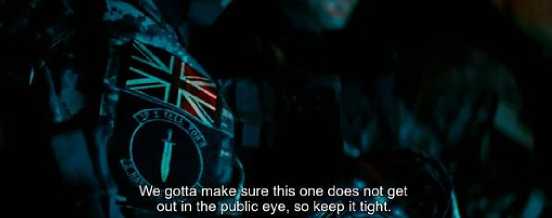
Data 2. Major Lennox: “we gotta make sure this one does not get out in the public eye, so keep it tight” – (Minute 03.34)
In this section, it appears that the context is to explain that this is the first scene where the first encounter from the fallen minion which is the deception army, it happened in the China region where team NEST began their first mission to take down the Decepticon. The first contact with the Fallen minion, it gives the sign that the mass attack later would happen.
The word we refers to Major Lennox who is the leader of team NEST which is a special force that was created one year ago after the first contact with the Transformer. In the scene, we used to represent how they are going to attack one of the fallen minions. The use of we, first-person plural, involves the speaker and team NEST. In these utterances, we describes the position of the speaker in the conversation as a lead role in the dialogue.
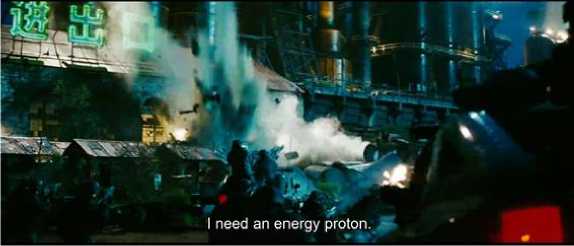
Data 3. “I need an energy proton “– (Minute 05.14)
The pronoun I: first person singular
Based on the picture above, team NEST was fighting against one of the biggest Decepticons that appeared in this movie. They have significant strikes on the enemy and one of the soldiers (i) needed extra ammo for his weapon. In this scene can be seen in a form of a group, but there’s only one speaker.
This deixis comes when the soldier I was talking to the other soldiers which were on the battlefield against the Decepticon. The weaponry that the soldier has are in needs the energy proton to recharge its own weapons in order to fire against the enemy ahead. the word I represents the soldier in a hectic situation whereas we can see in the picture above is in the middle of the war with the first minion of the fallen, later the soldier defeats the minion easily with the help of Autobots including Arcee, Ironhide, and Sideswipe.

Data 4. Dam I’m good – (Minute 07.02)
The pronoun I: first person singular
In this sentence, the deixis comes in when one of the Autobots characters named sideswipe came to chase one of the Decepticon. It appears that the character signifies the word I refers to how great his actions were, which in this utterance he said that himself are good at what he doing. By means slicing through the enemy’s body ultimately killing the enemy right on the spot. After the scene, he was needed in another agenda to help the NEST team that fighting other enemies.
The usage of the word I’m in this sentence was the same as the word I, the only difference was spelling. The use of I’m in this utterance directly refers to the speaker, Sideswipe himself. Since it is first person singular, it only refers to himself which is shown in the picture above.

Data 5. “Please listen to me! I want you to run! Run!” – (Minute 2.00.24)
The pronoun me: first person singular
The context of data 20 is when Sam Witwicky’s father, Ron Witwicky (me) told Sam Witwicky to run because there is a danger coming for him. In the picture above, Judy Witwicky (Sam’s mother) also got in the middle of the war situation. Both of them are the trap set up by the Decepticon to kill Sam Witwicky and collect the matrix of life. Later bumblebee comes to the rescue to save Sam Witwicky’s parents so do himself with Mikaela
Not only does one person deixis appear in this utterance, but the word I also refers to Ron himself because it is a subject that refers to the speaker itself. The word you represent second person deixis in this utterance. It refers to Sam Witwicky’s point of view, which in this case, it means he needs to run. The use of second-person deixis here is to know what the addressee needs to do
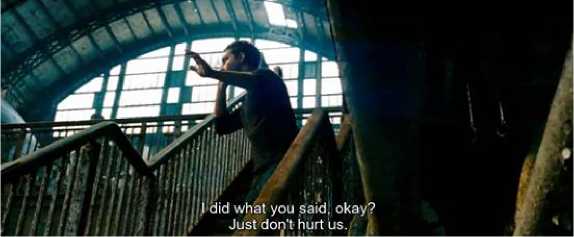
Data 6. “I did what you said okay? just don’t hurt us” – (Minute 56.15)
The pronoun us: first person plural
In this scene, Sam told the leader of Decepticon, Megatron, not to hurt his friends, he also told that the only thing was needed was Sam’s brain. Megatron wanted his brain because there was valuable information. It was not only for Megatron, but for Sam’s side.
The context of us in data 15 explains the speaker and other participants which was, Sam Witwicky himself and two of his friends who’s are his girlfriend Mikaela
and his roommate Leo. The usage of the word us can be referred both to himself or herself and to one or more other people. The usage of us can be used before a noun hurt in order to make it clear which group of people they are referring to.

Data 7. “It’s not fun for me, okay, Mikaela? And it smelled like a diesel…diesel!” – (Minute 52.36).
The pronoun me: first person singular
The deictic word comes in this utterance when the word me appears. It happens to be explaining Sam Witwicky himself. The rule to use the first-person word is when a person usually speaks about the things that happened to the speaker, the speaker’s own thoughts or basically the speaker himself. The word it in these utterances represents the female assassins as the third person deixis because Sam is tried to refer to the assassins’ lips which taste like a diesel motor since she is a robot transformer in a human form
In this utterance, me clarifies to Sam that he is in a stressful condition because earlier he gets kissed by the Decepticon assassins. In a way, Sam looked stressed because at the time the assassins kissed Sam, his girlfriend just arrived to visit him. The data were unique since it appears to have two deixis expressions in one sentence. There was first-person singular me and it as third person deixis.
Data 8. “This is not your planet to rule!” – (Minute 08.35)
The pronoun your: second-person plural In the picture above the utterances were a hidden message to the Autobots. The message itself is the first warning to the human race, team NEST, and the Autobots about the upcoming assault from the enemy side. Later on, in the movie, Optimus Prime was not aware enough of the warning which led him to his death. The utterance was continued with the line the fallen shall rise again where it translated to the Fallen will rule the world.
The context of your in data 3-29 explains that Demolishor told Optimus Prime (your) that earth is not his puppet or even his place where he thought that he would be a king. The second person point of view belongs to the person (or people) that are being addressed, which in this utterance the speaker uses your to refer to Optimus as the addressee. The word (you) addressed Optimus Prime which was uttered by Decepticon Demolishor.
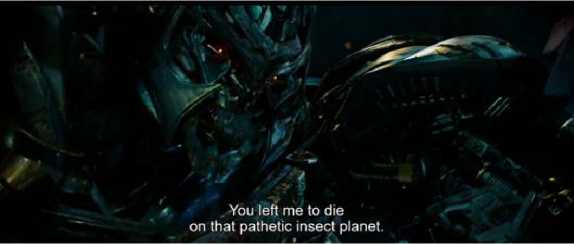
Data 9. “You left me to die on that pathetic insect planet” – (Minute 41.44)
The pronoun you: second person singular
The deictic word you in this context comes when Decepticon leader Megatron come to visit his fellow assistant Starscream in Cybertron. The use of you here was to refer to the addressee, Starscream in the picture above from the utterance itself, Megatron was being upset and angry at the same time because in the first sequel Megatron was killed because of the Allspark. At the same time, Starscream left Megatron because he was too scared to fight the military squadron and the Autobots since the Decepticon was outnumbered in that time.
The second person point of view is known as the “you” perspective. It is the perspectives of the person or persons that the speaker is addressing. In this utterance the word you refer to Starscream himself. The speaker, Megatron, uses the deictic expression you refer to the addressee, Starscream. The word you in this sentence uses a singular pronoun since the addressee in this utterance was only one Transformer.
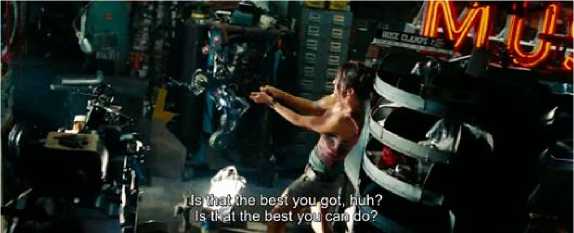
Data 10. “Is that the best you got huh? Is that the best you can do?” –(Minute 47.58)
The pronoun you: second person singular
Based on the picture above, Mikaela was attacking one of the Decepticon spies, RC. His job was to steal Megatron’s piece of Allspark which it stored in a safe inside Mikaela’s garage shop. Sam Witwicky told Mikaela to store it safely and never touch the piece because it will affect her as Sam Witwicky does. The piece of Allspark has two parts, one was stored in a heavily guarded base and the other one was locked in Mikaela’s garage shop. Later, the piece of Allspark became useless since it does not appear in the movie. The use of you in this utterance was uttered by the speaker, RC to point to the addressee.
The pronoun you as the second person singular in deixis describes the human character, Mikaela. The word you in this utterance signifies Mikaela herself. The usage of you in this utterance was simply to describe the point of view of Mikaela herself as the addressee.

Data 11. “Your world must not share the same fate as Cybertron” - (Minute 37.59)
The pronoun your: second-person plural
In this utterance, Optimus Prime shares his thought about the war that ended on his planet. The cause of the war was a simple problem where the power of the Allspark can rule and empower the entire army. Which then the Autobots knew this reason, they strictly hide the Allspark from the Decepticon, they believe Decepticon
will use the power of the Allspark to rule the entire galaxy, which is something the Autobots doesn’t want to happen.
The pronoun your as second person plural in deixis describes the context that Optimus Prime as the speaker explains the fate of his planet (Cybertron) lost because of the two sides’ conflict. It led to a war when eventually the war itself destroyed the whole of Cybertron. In this utterance, the word your use to represent Sam Witwicky himself. Since it is a second-person view, the use of your not only refers to Sam Witwicky but it does represent the plural function that leads to the entire human race on earth.
Data 12. “Run at it. Run for its feet! Move it!” – (Minute 1.58.40)
the pronoun it: third person singular.
The context of data (3-39) is when both word it appears in the dialogue. In the picture above, the situation was the same as in the previous data (data 3-38), they still fought the sucking machine Decepticon (Devastator). After they talked about certain things, they decided to run below it. As the picture above shows, the word it refers to the Decepticon Devastator as the main villain in this scene.
As Simmons speaks run for it, it means that he told the group to get a safe place under the Decepticon machine devastator (it). Clearly the word it refers to the Decepticon machine. Since it is an alien robot transformer, it does not represent any such kind as gender. The use of both it was to refer to the Decepticon, both it has the same function to refer to the transformer.

Data 13. “Don’t hurt them. This is what you want. You don’t want them”. – (Minute
2.00.33)
The pronoun them: third person plural
The pronoun them as third-person plural in deixis describes the parents of Sam Witwicky. The word them clarify his parent, Ron and Judy Witwicky. As a plural word, it means it has more than one person in the situation. A third-person point of view also means it refers not to the speaker or the addressee but clearly to a person near the conversation, just like in this utterance.
In this scene, his parents were being baited because the Decepticons wanted to trap and kill Sam Witwicky. Besides they wanted Sam Witwicky’s death, they also wanted the dust of Mitrix of life that Sam carried on his hand all the time during the war. Based on the picture above, Sam was scared that the Decepticon would hurt his parents, but luckily at the same time, his guardian Bumblebee arrived on time to defend his parent and himself. Eventually, Bumblebee defeated the Decepticon that tried to kill Sam and his parents.
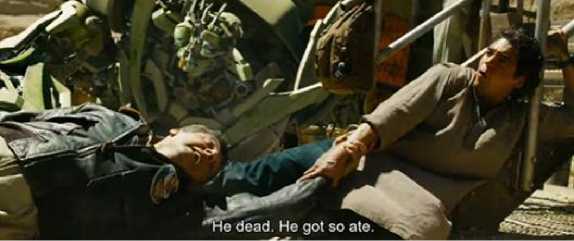
Data 14. “He dead. He got so ate” – (Minute 1.58.33)
The pronoun he: third person singular.
During the fight, the Decepticon pulls a huge sucking machine were it later sucks every single thing in front of him including Simmons, Leo, and the twins
Autobots. But the only one that did not hold on, was Mudflap who was sucked into the machine. Later, the mudflap wanted to give up on his life, he fought hard against the machine with his brother’s skids.
In this section, it appears that the context is to explain that he refers to Mudflap. The twins Autobots characters were in site fighting the sucking machine Decepticon, devastator. The third-person point he belongs to the people or person the narrator is referring to. In this case both word he refers to mudflap who got sucked into Devastator. The word he in this utterance was referred to a male transformer named Mudflap The speaker (skids) refers to him since he did not around them anymore when they were talking.
Data 15.
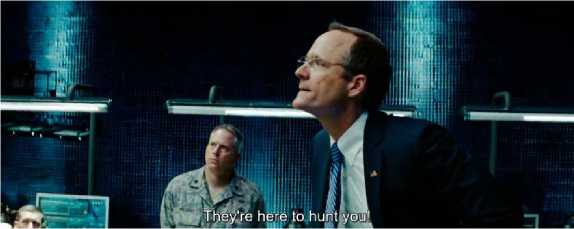
“They’re here to hunt you!” – (Minute 24.17)
The pronoun they: third person plural
Based on the picture above, Director Galloway was furious about the Autobots that was still circulating around earth. Director Galloway thoughts the Autobots should leave the earth after the first war in Washington D.C. He thoughts because of the Autobots still here on earth, they would keep coming since Autobots was their main rivalry. The main point from the speaker is, he wanted the Autobots to leave earth so they would also leave the planet alone.
In this utterance, the deixis they come when it is said by Director Galloway. In the data, they represent the Decepticon. The use of they in the utterance “they’re here to hunt you!” shows the third-person point of view. It belongs to people or things that are not included among the speakers.
CONCLUSION
After analyzing the data of person deixis in the movie Transformer: Revenge of The Fallen in the previous chapter, the result found that there are 40 data indicated as person deixis form. From the analysis of that social deixis, the following conclusion can be arrived at.
There were three forms of person deixis that were found in the film entitled Transformer: Revenge of The Fallen. First was first-person deixis. The data that showed first-person deixis in this movie are I, we, me, I’m, our, us. Secondly, second-person deixis form which is you, your. Lastly, the third-person deixis form which includes it, he, they, them.
The function of the data was able to reveal the conveyed reference meaning within deixis used in the film, meaning that the theories used in this study are indeed applicable. The whole characters in the film were able to reflect their position and give respect to specific addressees mentioned by giving them the suitable deictic expression in the utterance. Various reference meanings were able to be revealed, and those deictic markers prevented repetition in the film, although some of them used repetition but in a different context which elevates the clear picture that the sentences are not in cohesion. This puts the text off the rail and the intention of the writer is not entirely comprehensible to the reader.
BIBLIOGRAPHY
Aldi. 2012. Deixis used in Barack Obamas speech on the 15th anniversary of 9/11. Denpasar:
English Department Faculty of Arts Udayana University
Grundy, Peter. 2000. Doing Pragmatics. London: Oxford University Press.
Levinson, Steven C. 1983. Pragmatics. Cambridge: Cambridge University Press Nguyen Van Thao, Herman. An Analysis of Deixis to Song Lyrics My Heart Will Go on by
Celine Dion. Communication and Linguistics Studies. Vol. 6, No. 2, 2020, pp. 23-26. DOI: 10.11648/j.cls.20200602.12
Nur Kholis. Deixis Analysis of the Good Dinosaur the Movie Sekolah Indonesia. Kuala Lumpur
Simatupang. 2020 Pragmatic Analysis of Deixis in Joko Widodo’s Inauguration Speech In 2019 Volume 5 No 1. Widyatama University English Journal Literacy Utama ISSN 2654-5284 (print); ISSN 2655-4585 (online).
Elfrida. 2018. An Analysis of Deixis and Its Reference Used by Main character in A Thousand Words Movie Script by Steve Vol.2. No.1.2018 Page 68 of 85. University of Bengkulu, journal of English Education and Teaching (JEET)
Richards, Barry 1982 Discourse and Deixis vol 1. Journal of Semantics
Setyawati, Dwi. 2013. The Analysis of Deixis of The Novel Emma By Jane Austen. English
Major. State Institute of Islamic Studies
Stapleton, A. 2017. Deixis in Modern Linguistics. Essex Student Journal 9 (1).
Stephen C. Levinson. 1983. Cambridge Text books in Linguistics. Cambridge University Press.
Abdulameer. 2019. A Pragmatic Analysis of Deixis in a Religious Text. International Journal of English Linguistics; Vol. 9, No. 2; College of Education for Women,
Al Iraqia University, Baghdad, Iraq, Canadian Centre of Science and Education
Yule, George. 1996. Pragmatics. New York: Oxford University Press.
Yulfi. 2017. An Analysis of Deixis and Speech Act Used in English Teaching and Learning Process. Volume 1 No 1, STKIP PGRI Lubuklinggau Linguistic, English Education and Art (LEEA) Journal.
Zulkarnaen, 2014. An analysis on Deixis Used in Editor Choice of the Jakarta Post Online Edition. Study Program of English, Universitas Brawijaya.
AUTHOR’S PROFILE
I Putu Dion Ari Saputra is a 2018 English Department student of Udayana University, Faculty of Humanities. During his college days, he participated in several committee activities held on-campus or off-campus. In carrying out this activity, he has met many people and of course, he has developed a connection with those new people. and now in 2022, he is completing his final assignment at the campus he loves, the Faculty of Humanities.
135

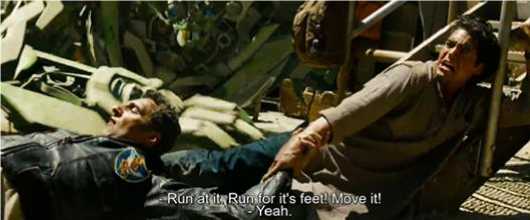
Discussion and feedback